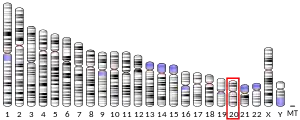Prokineticin receptor 2
Prokineticin receptor 2 (PKR2), is a dimeric[5] G protein-coupled receptor encoded by the PROKR2 gene in humans.[6]
| PROKR2 | |||||||||||||||||||||||||||||||||||||||||||||||||||
|---|---|---|---|---|---|---|---|---|---|---|---|---|---|---|---|---|---|---|---|---|---|---|---|---|---|---|---|---|---|---|---|---|---|---|---|---|---|---|---|---|---|---|---|---|---|---|---|---|---|---|---|
| Identifiers | |||||||||||||||||||||||||||||||||||||||||||||||||||
| Aliases | PROKR2, GPR73L1, GPR73b, GPRg2, HH3, KAL3, PKR2, dJ680N4.3, prokineticin receptor 2 | ||||||||||||||||||||||||||||||||||||||||||||||||||
| External IDs | OMIM: 607123 MGI: 2181363 HomoloGene: 16368 GeneCards: PROKR2 | ||||||||||||||||||||||||||||||||||||||||||||||||||
| |||||||||||||||||||||||||||||||||||||||||||||||||||
| |||||||||||||||||||||||||||||||||||||||||||||||||||
| |||||||||||||||||||||||||||||||||||||||||||||||||||
| |||||||||||||||||||||||||||||||||||||||||||||||||||
| |||||||||||||||||||||||||||||||||||||||||||||||||||
| Wikidata | |||||||||||||||||||||||||||||||||||||||||||||||||||
| |||||||||||||||||||||||||||||||||||||||||||||||||||
Function
Prokineticins are secreted proteins that can promote angiogenesis and induce strong gastrointestinal smooth muscle contraction. The protein encoded by this gene is an integral membrane protein and G protein-coupled receptor for prokineticins. PKR2 is composed of 384 amino acids. Asparagine residues at position 7 and 27 undergo N-linked glycosylation.[5] Cysteine residues at position 128 and 208 form a disulfide bond.[5] The encoded protein is similar in sequence to GPR73, another G protein-coupled receptor for prokineticins.[6] PKR2 is also linked to mammalian circadian rhythm.[7] Levels of PKR2 mRNA fluctuate in the suprachiasmatic nucleus, increasing during the day and decreasing at night.[7]
Mutations in the PROKR2 (also known as KAL3) gene have been implicated in hypogonadotropic hypogonadism and gynecomastia.[8] Total loss of PKR2 in mice leads to spontaneous torpor usually beginning at dusk and lasting for 8 hours on average.[9]
PKR2 functions as a G protein-coupled receptor, thus it has a signaling cascade when it's ligand binds. PKR2 is a Gq-coupled protein, so when the ligand binds, beta-type phospholipase C is activated which creates inositol triphosphate. This then triggers calcium release inside the cell.[10]
See also
References
- GRCh38: Ensembl release 89: ENSG00000101292 - Ensembl, May 2017
- GRCm38: Ensembl release 89: ENSMUSG00000050558 - Ensembl, May 2017
- "Human PubMed Reference:". National Center for Biotechnology Information, U.S. National Library of Medicine.
- "Mouse PubMed Reference:". National Center for Biotechnology Information, U.S. National Library of Medicine.
- Sposini S, Caltabiano G, Hanyaloglu AC, Miele R (January 2015). "Identification of transmembrane domains that regulate spatial arrangements and activity of prokineticin receptor 2 dimers". Molecular and Cellular Endocrinology. 399: 362–372. doi:10.1016/j.mce.2014.10.024. hdl:10044/1/31246. PMID 25449422. S2CID 13491537.
- "Entrez Gene: PROKR2 prokineticin receptor 2".
- Masumoto KH, Nagano M, Takashima N, Hayasaka N, Hiyama H, Matsumoto S, et al. (June 2006). "Distinct localization of prokineticin 2 and prokineticin receptor 2 mRNAs in the rat suprachiasmatic nucleus". The European Journal of Neuroscience. 23 (11): 2959–2970. doi:10.1111/j.1460-9568.2006.04834.x. PMID 16819985. S2CID 20510543.
- Narula HS, Carlson HE (November 2014). "Gynaecomastia--pathophysiology, diagnosis and treatment". Nature Reviews. Endocrinology. 10 (11): 684–698. doi:10.1038/nrendo.2014.139. PMID 25112235. S2CID 40159424.
- Jethwa PH, I'Anson H, Warner A, Prosser HM, Hastings MH, Maywood ES, Ebling FJ (June 2008). "Loss of prokineticin receptor 2 signaling predisposes mice to torpor". American Journal of Physiology. Regulatory, Integrative and Comparative Physiology. 294 (6): R1968–R1979. doi:10.1152/ajpregu.00778.2007. PMC 2735815. PMID 18417646.
- Martin C, Balasubramanian R, Dwyer AA, Au MG, Sidis Y, Kaiser UB, et al. (April 2011). "The role of the prokineticin 2 pathway in human reproduction: evidence from the study of human and murine gene mutations". Endocrine Reviews. 32 (2): 225–246. doi:10.1210/er.2010-0007. PMC 3365793. PMID 21037178.
Further reading
- Lin DC, Bullock CM, Ehlert FJ, Chen JL, Tian H, Zhou QY (May 2002). "Identification and molecular characterization of two closely related G protein-coupled receptors activated by prokineticins/endocrine gland vascular endothelial growth factor". The Journal of Biological Chemistry. 277 (22): 19276–19280. doi:10.1074/jbc.M202139200. PMID 11886876. S2CID 22935718.
- Soga T, Matsumoto Si, Oda T, Saito T, Hiyama H, Takasaki J, et al. (December 2002). "Molecular cloning and characterization of prokineticin receptors". Biochimica et Biophysica Acta (BBA) - Gene Structure and Expression. 1579 (2–3): 173–179. doi:10.1016/S0167-4781(02)00546-8. PMID 12427552.
- Battersby S, Critchley HO, Morgan K, Millar RP, Jabbour HN (May 2004). "Expression and regulation of the prokineticins (endocrine gland-derived vascular endothelial growth factor and Bv8) and their receptors in the human endometrium across the menstrual cycle". The Journal of Clinical Endocrinology and Metabolism. 89 (5): 2463–2469. doi:10.1210/jc.2003-032012. PMID 15126578.
- Pasquali D, Rossi V, Staibano S, De Rosa G, Chieffi P, Prezioso D, et al. (September 2006). "The endocrine-gland-derived vascular endothelial growth factor (EG-VEGF)/prokineticin 1 and 2 and receptor expression in human prostate: Up-regulation of EG-VEGF/prokineticin 1 with malignancy". Endocrinology. 147 (9): 4245–4251. doi:10.1210/en.2006-0614. PMID 16763065.
- Dodé C, Teixeira L, Levilliers J, Fouveaut C, Bouchard P, Kottler ML, et al. (October 2006). "Kallmann syndrome: mutations in the genes encoding prokineticin-2 and prokineticin receptor-2". PLOS Genetics. 2 (10): e175. doi:10.1371/journal.pgen.0020175. PMC 1617130. PMID 17054399.
External links
- GeneReviews/NCBI/NIH/UW entry on Kallmann syndrome
- "Prokineticin Receptors: PKR2". IUPHAR Database of Receptors and Ion Channels. International Union of Basic and Clinical Pharmacology.
This article incorporates text from the United States National Library of Medicine, which is in the public domain.




